In all the world, there are only a few species of plants that form rather remarkable ice sculptures when the air outside drops to sub-freezing temperatures. Of those, I’m lucky enough to grow one species, Frostweed (Verbesina virginica), in my garden.
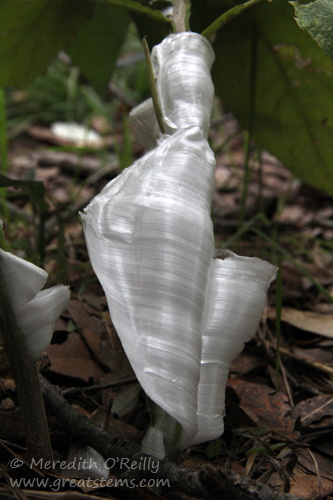 There were two reasons I started growing Frostweed in my wildlife garden. The first is that it is a valuable nectar source for pollinators, especially migrating Monarchs, during its bloom time in the fall. The second is that when conditions are right in the late fall or winter, beautiful curling ice ribbons might exude from the stem’s outer layers.
There were two reasons I started growing Frostweed in my wildlife garden. The first is that it is a valuable nectar source for pollinators, especially migrating Monarchs, during its bloom time in the fall. The second is that when conditions are right in the late fall or winter, beautiful curling ice ribbons might exude from the stem’s outer layers.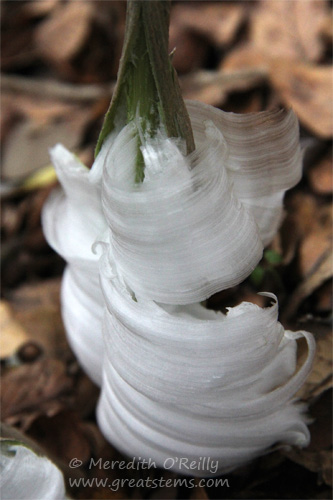 As temperatures drop, supercooled sap increases the pressure between the stem’s secondary xylem core and the epidermis. When the epidermis can no longer withstand the pressure, it splits open. The emerging sap produces the start of icy creations as the water cools quickly and begins to freeze. Then, because the internal pressure was reduced with the split of the epidermis, water from the plant’s roots moves upward and outward toward the split, contributing to the spectacular sculptures.
As temperatures drop, supercooled sap increases the pressure between the stem’s secondary xylem core and the epidermis. When the epidermis can no longer withstand the pressure, it splits open. The emerging sap produces the start of icy creations as the water cools quickly and begins to freeze. Then, because the internal pressure was reduced with the split of the epidermis, water from the plant’s roots moves upward and outward toward the split, contributing to the spectacular sculptures.
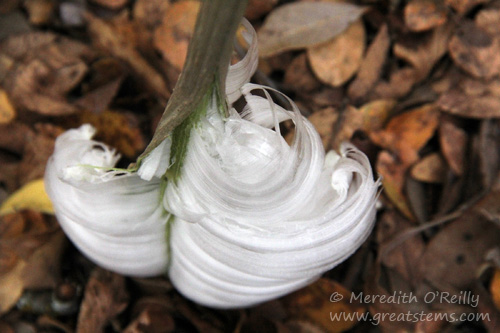
When the water first emerges where the epidermis splits, it does so at right angles to the core, because it exits from single rays which move water peripherally from the pith (center core) toward the living cortex and outer cells, the epidermis.
The beautiful ice ribbons form as water touches adjacent ice crystals and freezes, a repeating process.
The ribbons are thin and delicate. They melt almost instantly when held.
In this image, note the living cortex just inside the epidermis, easily seen where the split starts to taper.
Ice sculptures from Frostweed typically appear at the plant’s base, close to the roots, but this isn’t always the case. Above, the ribbons begin appearing about an inch off the ground. They continue emerging for much of the plant’s stem. As you can see from the plant’s green leaves, the plant was not in a dormant state at the time of the freeze, and water existed well up the stem. This allowed for a particularly impressive ice creation. An unusually hard freeze early in the season might provide the conditions for such a tall sculpture.
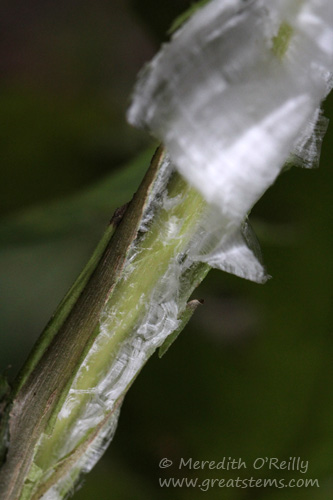 The stem itself does not split. In fact, it can produce additional formations as freezing temperatures occur again in the season. Subsequent formations will usually move lower to the base of the stem, near the roots.
The stem itself does not split. In fact, it can produce additional formations as freezing temperatures occur again in the season. Subsequent formations will usually move lower to the base of the stem, near the roots.
Higher up the stem on a Frostweed plant, decreased pressure might allow the epidermis to split but not emerge forcefully enough to create ribbons.
Why is Frostweed able to do this, while most other plants cannot? A closer study indicates that during freezing temperatures, water must be present in the cortex and tissue just inside the epidermis; typically in Frostweed this occurs at least near base of the plant. Also, the secondary xylem of Frostweed is woody, which allows a framework against which internal pressure from the supercooled sap will push out and lead to the rupture of the epidermis. Additionally, Frostweed’s xylem rays allow water to flow laterally at right angles to the transport tissues, a big factor in the creation of the ice ribbons.
The above image shows the blooms of this excellent wildlife plant. Frostweed grows readily in shade from seed, looking its best in natural woody settings. It can reach heights of 6-8 feet, with clusters of white blooms opening up with copious nectar in fall. I find it a beautiful plant most of the year, but as it grows big, it might flop over, and as the seasons turn cool the foliage admittedly will become less attractive.
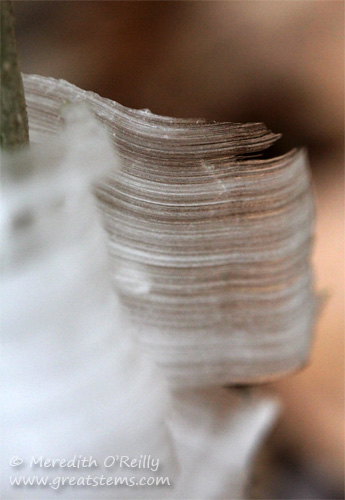
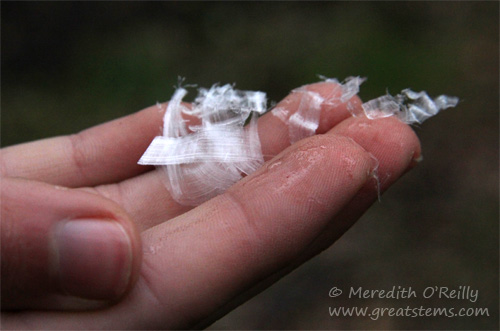
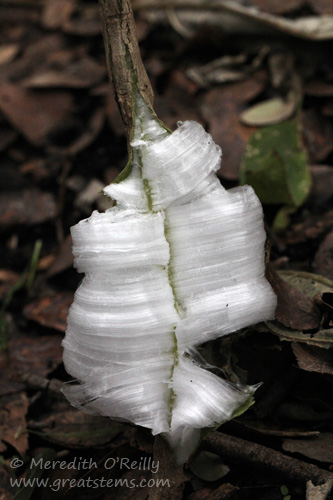
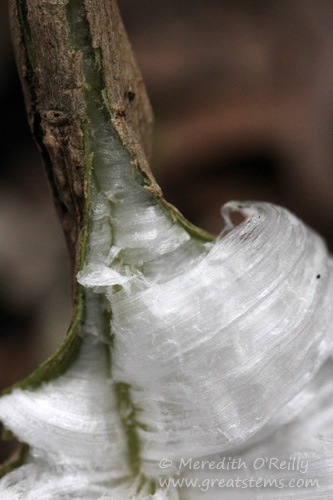
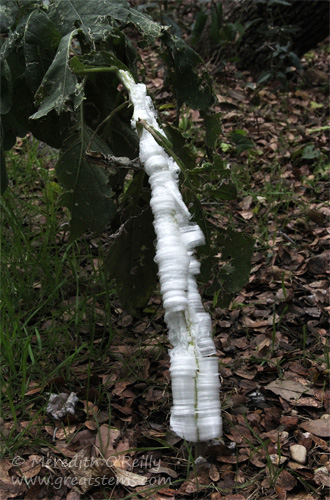
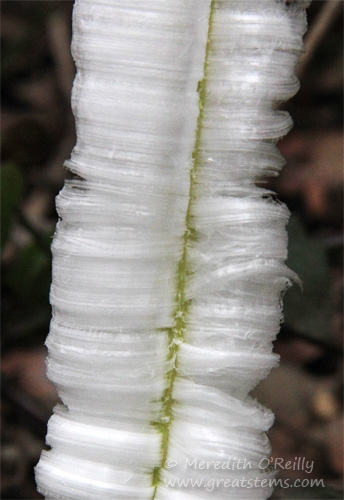
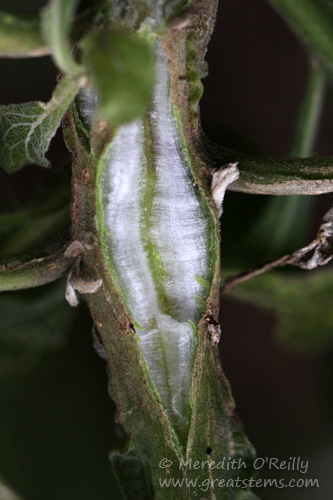
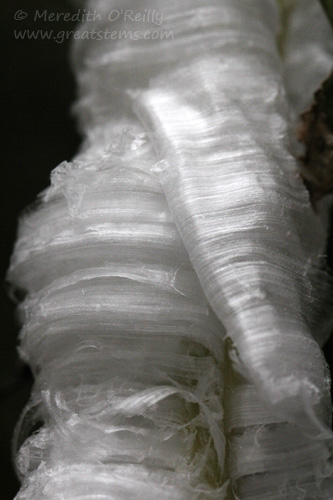
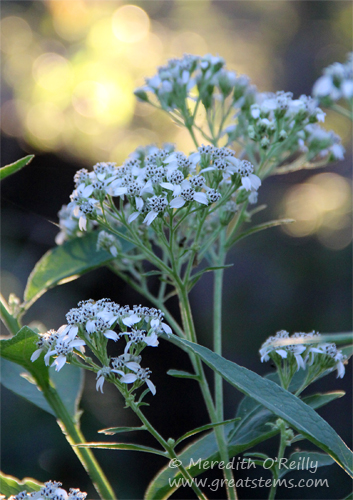
I look out for these “frost flowers” every year, but as you say they only form under the right conditions, and by certain plants. In my garden it’s Salvia coccinea that typically produces these wonders, although I think I’ve seen them on a couple other plants too. (It’s been a few years since I’ve seen frost flowers in my garden.)
Wonderful photos!
The most magical think I found in the Texas Hill Country was frostweed ice formations.
I went to Missouri Botanical Gardens once and saw an entire exhibit of about 30 – 40 giant photographs of just frostweed sculptures. I made sure to let it live on in my daughter’s property.
I remember seeing Frostweed on other blogs, too, but never a display as impressive as this one. Wow! What a fascinating plant. It’s only hardy to zone 6a (I’m in 5a), but apparently there are some plants in zone 5 that do this, too. I’ll have to do a little more research. Very impressive.
Beautiful photos!!
These are amazing! Would I be able to plant these as an annual in New York?
Marfisa, I don’t know that it grows in New York, but it seems to be nearby in Pennsylvania and Maryland. So it sounds like a possibility. Generally I think of it as a plant found in the southern half and more the middle of the country.
I saw my first frostweed ice sculptures this morning in North Texas. So beautiful and delicate. I’m glad I found your article. It was very informative and I love your photos. Thanks for sharing!
I’m glad you liked the post, Alise — I’m even more happy that you got to see the beauty of frozen frostweed in person!
I just spent the morning trimming back old stalks of last year’s Frost Weed in the Enchanted Forest Sanctuary . In central coastal florida we will probably never see this beautiful phenomenon, although we can enjoy the flowers and butterflies . Thank you for the gorgeous photos .
I’m glad you liked them, Mary. You might not get freezing temperatures in your area, but perhaps one day you’ll travel in winter and get to see them in person. In any case, I’m happy that my photos gave you a chance to view winter frostweed. Thank goodness photography allows us to travel the world from home to see things we might not ever see otherwise. This one is minor but think of all the wildlife and plants found only in hard-to-reach places of the world — so grateful for photographers!